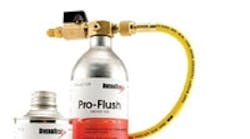It may be stating the obvious, but anyone seeking a repair technician is in an anxious frame of mind. Machinery in need of repair is inconvenient, annoying, and an unwanted expense. So it’s with a sense of concern and trepidation that the HVAC technician is “called in to have a look.”
There are three things that matter to the customer: knowing the cost, having the problem repaired, and making certain that it doesn’t happen again. It’s completely up to the HVAC technician to deliver the best “fix”, at a reasonable cost and with some guarantee that it won’t happen again.
Causes of Compressor Burnout
Poor maintenance or an electrical event such as a power surge can cause a compressor to burn out. But by far the most common cause of compressor failure is due to acid in the system. When air or moisture enters into the system a chemical reaction takes place. This chemical reaction produces hydrochloric and/or hydrofluoric acids as byproducts. Over time, these acids eat away at the compressor and system parts. This damages the compressor and results in sludge and particles building up against the walls of the system lines, setting the stage for future malfunction.
Diagnostic Steps
The first symptom of compressor burnout may come when someone notices that the fan is running but no cool air is produced. Upon inspection it becomes clear that the fan motor is running but the compressor is not. There are several, relatively simple tests you can perform. A good acid testing kit will identify if there is acid in the system. Taking a resistance (ohms) measurement will reveal an open circuit in the compressor windings. But perhaps the simplest method is the “odor test.” The smell that comes when a hose is connected to the system is both pungent and revealing. Once sniffed, it’s never forgotten and is one of the best indicators of a compressor burn-out.
Time Estimate
If the first question is, “How much will it cost?” the second question is definitely going to be, “How long will it take?” Any time estimate presumes all of the necessary equipment and replacement parts are readily available. For a very small system it may be possible to complete the work in three to four hours. A five-ton system would more likely take eight hours. It would take two men approximately 1-1/2 days to complete the work on a 15-ton system and any system larger than that could take two men up to three days.
Choose the Correct Equipment and Tools
Someone once said, “A good start is half the job.” With that in mind, it’s important to ensure you have the necessary equipment ready and that all proper safety precautions are taken. The size of the system, manufacturer recommendations and safety concerns dictate what equipment, materials and gear are required to complete the work
Because of the acids, solvents, and residues involved, replacing a burnt-out compressor is a highly toxic task. It’s very important that the work environment be well-ventilated and properly lit. Ensure that all electrical components are disconnected. The standard safety equipment includes a resealable waste container, absorbent shop clothes, rubber gloves, and safety goggles. As work progresses, make certain to avoid any skin or eye contact with the system residues or solvents.
Manufacturers’ recommendations provide the best advice when it comes to choosing the replacement compressor. These recommendations will also provide the specifications for both the suction line drier and liquid line drier. Both lines are needed for this job. The suction line drier protects the compressor and the liquid line drier protects the meter and other components. A nitrogen tank (with regulator) and a vacuum pump (with accessories) will be needed as well.
Choosing the best flushing product involves several considerations. The size of the system, manufacturer recommendations and your personal preferences all play a role in the decision. Aerosols might be a convenient choice for a very small system. But they can be expensive and wasteful when completing larger jobs. Traditional single-flush products are sufficient for larger systems and generally provide a good result. Finally, solvent toxicity and flammability may also have an influence on which product will be used.
Replace the Compressor
1. Start by evacuating the system using approved techniques and proper recovery equipment.
2. Take the electrical system off-line and remove the old compressor.
3. Remove the filter drier cores, check valve and reversing valves on the heat pumps. It may be faster, and less expensive, to by-pass the filter drier, check valves and reversing valves with a bypass loop.
4. Prepare the discharge port by connecting the re-sealable waste container to capture the flushed acidic contaminants. It’s also a good practice to restrict the solvent flow at the discharge port. Restricting the flow will maximize the solvent contact time and increase the efficiency of the flush. It also minimizes the amount of solvent required to thoroughly cleanse the system.
5. Attach the solvent injector to the inlet port and run the flushing solvent through the system according the product instructions. The amount of solvent needed to thoroughly flush the system will depend on the size of the system as well as the amount of contamination found within it.
6. It’s a good idea to check the waste container occasionally, to ensure that it’s catching all of the solvent and captured contaminants.
7. Once you believe the system is clear, remove the solvent injector from the inlet port and connect the hose from the nitrogen tank.
8. Purge the system at 150 psi for one to two minutes to remove all trace amounts of oil residue and solvents. If the exiting solvent remains cloudy, then repeat the one-to-two minute nitrogen purge.
9. Once the exiting solvent is clear you can disconnect the waste container.
10. Ensure that the waste material is disposed of according to federal, state and local regulations.
Bring the System Back Online
Bring the system back to working order by installing the new compressor, filter drier core, the check valves and reversing valves. If you used a bypass loop then remove and reconnect the lines. Using a vacuum pump with clean oil you should evacuate the system to a low micron reading (500 microns is usually adequate). Under ordinary circumstances the evacuation time is approximately three minutes per ton.
Next, check the system for leaks. Once any discovered leaks are repaired, recharge system with refrigerant and oil per the equipment manufacturer’s recommendations. Finally, reconnect the electrical connections and test the system according to the manufacturer’s recommendations.
Getting it Right the First Time
If a newly-replaced compressor breaks down in less than three months, it’s most commonly the result of an incomplete system flush. A less-thanthorough system flush leaves residue and contaminants inside the system, which will quickly wear down the new compressor. When examined under warranty, it becomes clear that the damage was caused by the residual material, and the warranty will be voided. This kind of situation produces more anxiety, increases costs, and damages the reputation of the HVAC technician.
A complete, thorough system flush safeguards the life and the warranty of the newly-installed compressor, reduces costs and relieves customer anxiety. An HVAC technician that does all that is surely going to have an enhanced reputation.
Dave Irvin is a chemical product specialist for DiversiTech Corporation, Duluth, GA. He can be reached by calling 678/542-3600.
Flushing Option
The Pro-Flush™ kit from DiversiTech contains a reusable injector gun, refillable injection tank, charging hose, a rubber gun-tip adapter, and one can of Pro-Flush solvent.
The injector gun allows for multiple bursts or mini-flushes, which company sources say have proven to be more efficient than the solventwasting, single-flush method. The Pro-Flush solvent blend can be used when changing from R-22 (mineral oil) to R-410A (POE oil), refrigerant conversions, and as a post-compressor burnout system flush. One can is included in the Pro-Flush kit and additional solvent can be purchased separately.
Pro-Flush safety features include a built-in pressure regulator. DiversiTech sources say the Pro- Flush solvent conforms to the Environmental Protection Agency (EPA) Significant New Alternatives Policy (SNAP), is ozone safe, nontoxic, non-flammable and non-VOC.









